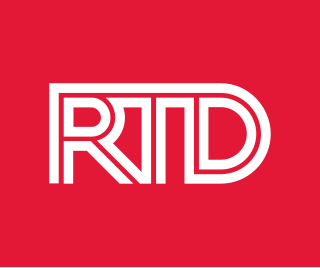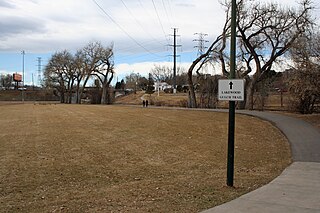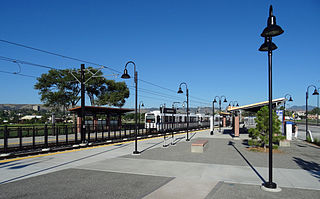
The Regional Transportation District, more commonly referred to as RTD, is the regional agency operating public transit services in eight out of the twelve counties in the Denver-Aurora-Boulder Combined Statistical Area in the U.S. state of Colorado. It operates over a 2,342-square-mile (6,070 km2) area, serving 3.08 million people. RTD was organized in 1969 and is governed by a 15-member, publicly elected Board of Directors. Directors are elected to a four-year term and represent a specific district of about 180,000 constituents.

The C Line was a light rail line, part of the rail system operated by the Regional Transportation District in the Denver-Aurora Metropolitan Area in Colorado.

The D Line is a light rail line which is part of the rail system operated by the Regional Transportation District in the Denver–Aurora Metropolitan Area in Colorado. The D line was the first line in the system when it opened in 1994, traveling from downtown Denver to I-25 and Broadway as the Central Corridor. It was extended along the Southwest Corridor in July 2000. Because it was the first and only line in the system it had no letter or color designation until the Central Platte Valley Spur opened on April 5, 2002, although on maps it was designated as Route 101.

The R Line or Aurora Line/I-225 Rail is a Regional Transportation District (RTD) light rail line that serves stations in Aurora, Denver, Greenwood Village, Centennial and Lone Tree. Opening on February 24, 2017, the line was designated as the “R” line, reflecting the letter R’s in “Aurora” and “Ridgegate”.

The H Line, part of the light rail system operated by the Regional Transportation District in the Denver-Aurora Metropolitan Area in Colorado, was added to the system on November 17, 2006, with the completion of the Southeast Corridor project. It is one of four routes that are part of the RTD's service plan for the corridor.

Lakewood Gulch drains a section of Lakewood and west Denver, Colorado into the South Platte River. It is the historic location of the old Interurban Shortline Railway and, in 2008, is a greenbelt that includes Rude Park, Sanchez Park and Lakewood Gulch Park. The gulch passes through Lakewood from west to east before entering the Denver neighborhoods of Sun Valley and Villa Park. It contains a part of the route of the (current) heritage streetcar Platte Valley Trolley and the Denver sections of the creek have an adjacent bike path. According to the Jefferson County Colorado Place Names Directory, "Lakewood Gulch originates on the north east foot of Green Mountain in Lakewood, flows east through Sixth Avenue West Park and Red Rocks Community College and continues east through Lakewood into Denver, where it joins the South Platte River southwest of the intersection of I-25 and Colfax Avenue."

Auraria West station is an RTD light rail station in Denver, Colorado, United States. Operating as part of the E and W Lines, the station opened on April 5, 2002, and is operated by the Regional Transportation District. It primarily serves the adjacent Auraria academic campus, home to Metropolitan State University of Denver, the Community College of Denver, and the University of Colorado Denver.

The A Line is a Regional Transportation District (RTD) commuter rail line serving Denver and Aurora, Colorado, operating between downtown Denver and Denver International Airport (DIA). During planning and construction, it was also known as the East Rail Line, but most locals refer to it as the A Line. Despite its former title, the line does not serve the campuses of the University of Colorado.

Jefferson County Government Center–Golden station is an at-grade light rail station on the W Line of the RTD Rail system. It is located near the intersection of 6th Avenue and Johnson Road, on grounds of the Jefferson County Government Center in Golden, Colorado, after which the station is named.

Red Rocks College is an at-grade light rail station on the W Line of the RTD Rail system. It is located alongside 6th Avenue at its intersection with Arbutus Drive in Lakewood, Colorado. The station is located approximately 1⁄2 mile (0.8 km) to the north of the Red Rocks Community College campus, after which the station is named.

Oak is an at-grade light rail station on the W Line of the RTD Rail system. It is located near the intersection of West Colfax Avenue and Oak Street, after which the station is named, in Lakewood, Colorado. The station is located within the Lakewood Industrial Park.

Garrison is an at-grade light rail station on the W Line of the RTD Rail system. It is located near the intersection of West 13th Avenue and Garrison Street, after which the station is named, in Lakewood, Colorado.

Lakewood–Wadsworth is an elevated light rail station on the W Line of the RTD Rail system. It is located alongside West 13th Avenue on a bridge over Wadsworth Boulevard, in Lakewood, Colorado, after which the station is named.

Lamar is an at-grade light rail station on the W Line of the RTD Rail system. It is located near the intersection of West 13th Avenue and Lamar Street, after which the station is named, in Lakewood, Colorado. The station is located within Lakewood's 40 West Arts District, not far from the businesses on West Colfax Avenue and about 0.7 miles (1.1 km) from the campus of the Rocky Mountain College of Art and Design.

Sheridan is a below grade light rail station on the W Line of the RTD Rail system. It is located alongside the banks of the Lakewood Gulch under Sheridan Boulevard, after which the station is named. The station straddles the border between Denver and Lakewood, Colorado, but RTD lists the station as being in the city of Denver. A marking etched into the platform indicates the border location.

Perry is an at-grade light rail station on the W Line of the RTD Rail system. It is located alongside the banks of the Lakewood Gulch at its intersection with Perry Street, after which the station is named, in Denver, Colorado.

Knox is an at-grade light rail station on the W Line of the RTD Rail system. It is located alongside the banks of the Lakewood Gulch at its intersection with Knox Court, after which the station is named.

Decatur–Federal is an at-grade light rail station on the W Line of the RTD Rail system. It is located alongside the banks of the Lakewood Gulch between its intersections with Decatur Street and Federal Boulevard, after which the station is named, in Denver, Colorado. The station is located in the Sun Valley neighborhood, near the point where Lakewood Gulch meets the South Platte River. It is one of two light rail stops that serve Empower Field at Mile High, the home stadium of the Denver Broncos. The stop is adjacent to Rude Park.

The N Line, also known as the North Metro Rail Line during construction, is a commuter rail line which is part of the commuter and light rail system owned by the Regional Transportation District (RTD) in the Denver metropolitan area in Colorado. The first 13 miles (21 km) from downtown Denver to 124th Avenue in Thornton opened as part of the FasTracks expansion plan on September 21, 2020. When fully built out the line will be 18.5 miles (29.8 km) long and pass through Denver, Commerce City, Northglenn, and Thornton. The N Line features Colorado's longest bridge at 9,533 feet called the Skyway Bridge. While other RTD commuter lines are operated by Denver Transit Partners for RTD, this is the only line operated by RTD itself.




















